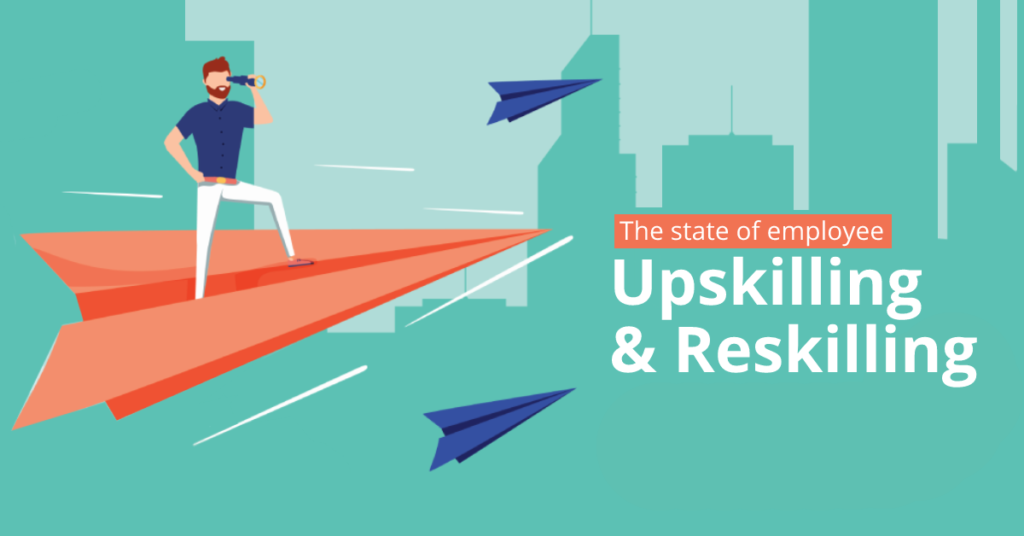
Table of Contents
Introduction of upskilling and reskilling:
Upskilling and reskilling: In a fast-paced professional world, the key to staying relevant and achieving unstoppable success lies in the continuous development of skills. Upskilling and reskilling have become essential strategies for career empowerment, allowing individuals to navigate the ever-evolving job landscape with confidence.
Understanding the Current Job Landscape
The rapid changes in industries today demand a high level of adaptability. Careers are no longer linear, and professionals must embrace a mindset of continuous growth to thrive in this dynamic environment.

Differentiating Upskilling and Reskilling
Upskilling involves enhancing existing skills, while reskilling is about acquiring entirely new skills. Recognizing the distinction between the two is crucial for effective career planning. upskilling and reskilling
Upskilling and Reskilling: Upskilling vs. Reskilling: Navigating the Learning Landscape
In the ever-evolving realm of professional development, two terms often take center stage: upskilling and reskilling. While they might sound similar, they carry distinct meanings and implications for your career trajectory.
Definition of upskilling and reskilling:
Upskilling: Enhancing Existing Skills
Defining Upskilling: Upskilling involves the process of refining and enhancing your current skill set. It’s like giving your skills a power boost, upgrading them to meet the demands of the evolving job market.
Example: If you’re a graphic designer proficient in Adobe Photoshop, upskilling might involve mastering advanced features or learning additional design software to broaden your capabilities.
Reskilling: Acquiring New Skills
Defining Reskilling: On the flip side, reskilling is a more radical shift. It refers to acquiring entirely new skills that might be unrelated to your current expertise. It’s like turning the page to a new chapter in your professional book.
Example: Consider a marketing professional making a leap into data science. That’s not just upskilling; it’s a strategic reskilling move, embracing a different domain.
Why Differentiate upskilling and reskilling ?
- Career Adaptability:
- Upskilling enhances your current role, making you more adaptable within your existing career path.
- Reskilling equips you for a career shift, fostering adaptability in a broader professional landscape.
- Market Relevance:
- Upskilling maintains your relevance in your current field.
- Reskilling ensures your relevance in emerging industries or professions.
- Long-Term Strategy:
- Upskilling is a continuous, incremental process, keeping you abreast of industry advancements.
- Reskilling is a strategic, occasional shift, preparing you for substantial career changes.
Identifying Your Skill Gaps
Understanding where you stand in terms of skills is the first crucial step towards professional growth. Identifying your skill gaps provides a roadmap for targeted development, ensuring you stay relevant in your field. Let’s delve into effective strategies to pinpoint those areas that need a little extra attention.
Self-Assessment Techniques
- Reflect on Your Role:
- Take a close look at your current job responsibilities. Are there tasks that you find challenging or areas where you wish you could contribute more effectively? These could be indicators of skill gaps.
- Feedback from Peers and Superiors:
- Seek constructive feedback from colleagues and supervisors. Their insights can offer a different perspective on areas where you excel and areas that might benefit from improvement.
- Industry Benchmarking:
- Compare your skills to industry standards. Identify the skills that are highly valued in your profession and assess where you stand in relation to those benchmarks.
Tools and Resources for Skill Assessment
- Online Skill Assessment Platforms:
- Utilize online tools and platforms that offer skill assessments. These often include quizzes, tests, or interactive exercises designed to evaluate your proficiency in specific areas.
- Professional Development Surveys:
- Participate in surveys related to professional development within your industry. These surveys can provide insights into the skills most in demand and help you identify gaps in your skill set.
- Mentorship and Guidance:
- Seek guidance from mentors or industry experts. Their experience can help you identify blind spots in your skill set and provide valuable advice on areas for improvement.
Creating Your Skill Gap Inventory
- List Your Current Skills:
- Start by creating a comprehensive list of the skills you currently possess. This serves as a foundation for identifying gaps.
- Compare with Job Descriptions:
- Analyze job descriptions for roles you aspire to or for career advancement opportunities. Identify the skills listed as requirements and compare them with your current skill set.
- Prioritize Based on Goals:
- Prioritize the identified gaps based on your career goals. Focus on skills that align with your aspirations and are in high demand in your industry.
Ongoing Monitoring
- Regular Check-ins:
- Schedule regular check-ins with yourself to reassess your skill inventory. As your career evolves, so do the skills in demand.
- Industry Trends:
- Stay informed about industry trends and technological advancements. This proactive approach ensures you stay ahead of the curve and continually address emerging skill requirements.
Identifying your skill gaps is not a one-time task; it’s an ongoing process of self-awareness and adaptability. Embrace the journey of continuous improvement, and you’ll find yourself well-equipped to navigate the ever-changing landscape of your professional domain.
Setting Clear Career Goals
Goal-setting is the compass that guides your career journey. Aligning your goals with industry trends ensures that you invest your time and effort in acquiring the most relevant upskilling and reskilling.
Navigating the intricate landscape of a successful career requires more than just skills; it demands a clear sense of direction. Setting well-defined career goals acts as your compass, guiding you through the dynamic professional journey. Let’s explore how to articulate and pursue goals that propel you towards the pinnacle of success.
Importance of Goal Setting
- Clarity and Focus:
- Clearly defined goals provide a focal point for your efforts. They help you concentrate on what truly matters in your career.
- Motivation and Commitment:
- Goals serve as powerful motivators. When you have a clear vision of where you want to go, you’re more likely to stay committed and overcome obstacles.
- Professional Development:
- Setting goals encourages continuous learning and development. It pushes you to acquire new skills and stay relevant in a rapidly evolving professional landscape.
Aligning Goals with Industry Trends
- Industry Research:
- Stay informed about the latest trends and developments in your industry. Understanding where the field is headed allows you to align your goals with the evolving demands of the job market.
- Networking and Insights:
- Engage with professionals in your field through networking events, conferences, or online platforms. Gain insights into the skills and qualifications that are highly valued in your industry.
SMART Goal Framework
- Specific:
- Define your goals with precision. Rather than a vague aim like “advance in my career,” specify a goal like “attain a leadership position within the next three years.”
- Measurable:
- Establish measurable criteria to track your progress. Quantifiable milestones provide a tangible way to evaluate your success.
- Achievable:
- Set goals that are challenging yet realistic. Consider your current skill set, resources, and time frame to ensure your goals are attainable.
- Relevant:
- Align your goals with your overall career aspirations. Ensure they contribute meaningfully to your professional growth and fulfillment.
- Time-Bound:
- Assign a timeline to each goal. A timeframe creates a sense of urgency and helps you stay focused on achieving your objectives within a defined period.
Crafting Your Career Goals
- Short-Term Objectives:
- Outline specific goals for the next 6-12 months. These could include acquiring a new certification, mastering a relevant skill, or completing a significant project.
- Mid-Term Aspirations:
- Look ahead to the next 1-3 years. Consider goals related to career advancement, leadership roles, or specialization in a particular area.
- Long-Term Vision:
- Envision your career 5-10 years down the line. Set ambitious yet achievable goals that align with your overarching career vision.
Flexibility and Adaptability
- Periodic Review:
- Regularly review and reassess your goals. As your career evolves, your goals may need adjustments to stay in sync with your aspirations and the changing professional landscape.
- Embrace Change:
- Be open to modifying your goals based on unforeseen circumstances or new opportunities. Flexibility ensures you can adapt to the twists and turns of your professional journey.
setting clear career goals is not just a one-time exercise; it’s an ongoing process of refinement and adaptation. By aligning your goals with industry trends, employing the SMART framework, and staying flexible, you empower yourself to
Choosing the Right Learning Resources
The internet offers a plethora of learning opportunities, from online courses to workshops and certifications. Choosing the right resources that suit your learning style is crucial for a successful upskilling or reskilling experience.
Creating a Personalized Learning Plan
One size does not fit all when it comes to learning. Tailoring your learning plan to your individual needs, preferences, and pace ensures a more effective and enjoyable learning experience.
Building a Professional Network
Networking is a powerful tool in career development. Utilizing online platforms and engaging with professionals in your industry can open doors to new opportunities and collaborations.
Applying New Skills in Real-world Scenarios
The true test of upskilling and reskilling lies in applying the acquired knowledge in real-world situations. Showcasing your skills to employers through projects and practical experiences enhances your credibility.
Monitoring and Adapting
Skills that are relevant today may become obsolete tomorrow. Regularly reassessing the relevance of your skills and staying informed about industry changes ensures that you stay ahead of the curve.
Success Stories
Real-life success stories inspire and provide valuable insights. Discover how individuals mastered the art of upskilling and reskilling, learning from their experiences and applying similar strategies to your journey.
Overcoming Challenges
Challenges are inevitable, but with the right mindset and strategies, they can be overcome. Explore common obstacles in the upskilling process and discover effective ways to tackle them.
Measuring Success
Identifying key performance indicators allows you to measure your success along the upskilling journey. Celebrate milestones and use them as motivation to keep pushing forward.
Future Trends in Skills Development
Stay ahead of the curve by exploring emerging skills in various industries. Anticipating future career demands ensures that you proactively acquire the skills needed for tomorrow’s jobs.
Conclusion
Empowering your career through upskilling and reskilling is a journey worth taking. By following these strategic steps, you not only stay relevant but also position yourself for unstoppable success in the ever-changing professional landscape.
Frequently Asked Questions (FAQs)
- How often should I reassess my skills in the ever-changing job market?
- Regularly reassess your skills at least once a year or whenever there are significant industry changes.
- Are online courses as effective as traditional classroom learning for upskilling?
- Yes, online courses can be just as effective, providing flexibility and access to a wide range of resources.
- Can I upskill or reskill while working a full-time job?
- Absolutely. Many online platforms offer courses designed for working professionals, allowing you to balance learning with your job.
- What is the best way to showcase my newly acquired skills to potential employers?
- Create a portfolio showcasing projects where you applied your skills and highlight your achievements on your resume.
- How do I stay motivated throughout the upskilling journey?
- Set short-term goals, celebrate small victories, and connect with a supportive community to stay motivated and engaged.









